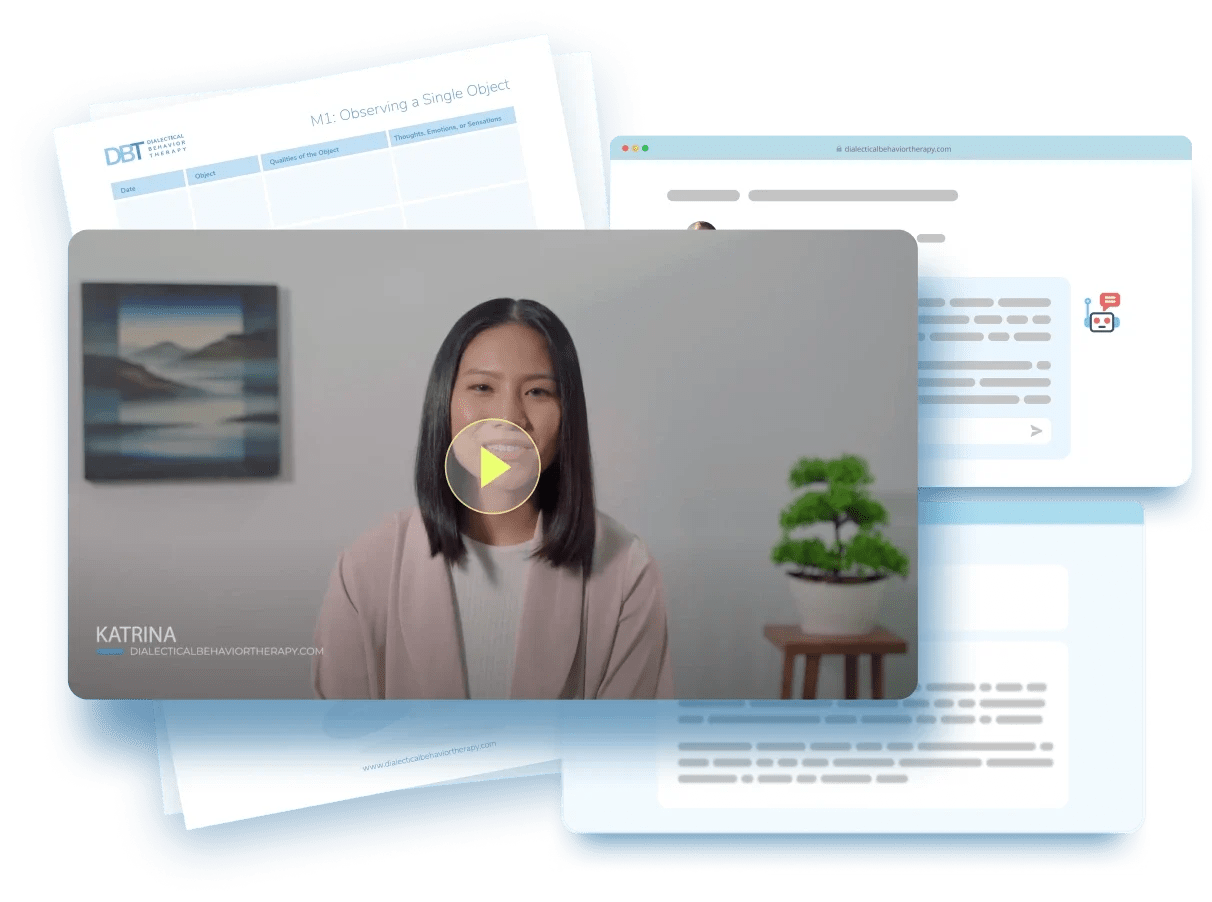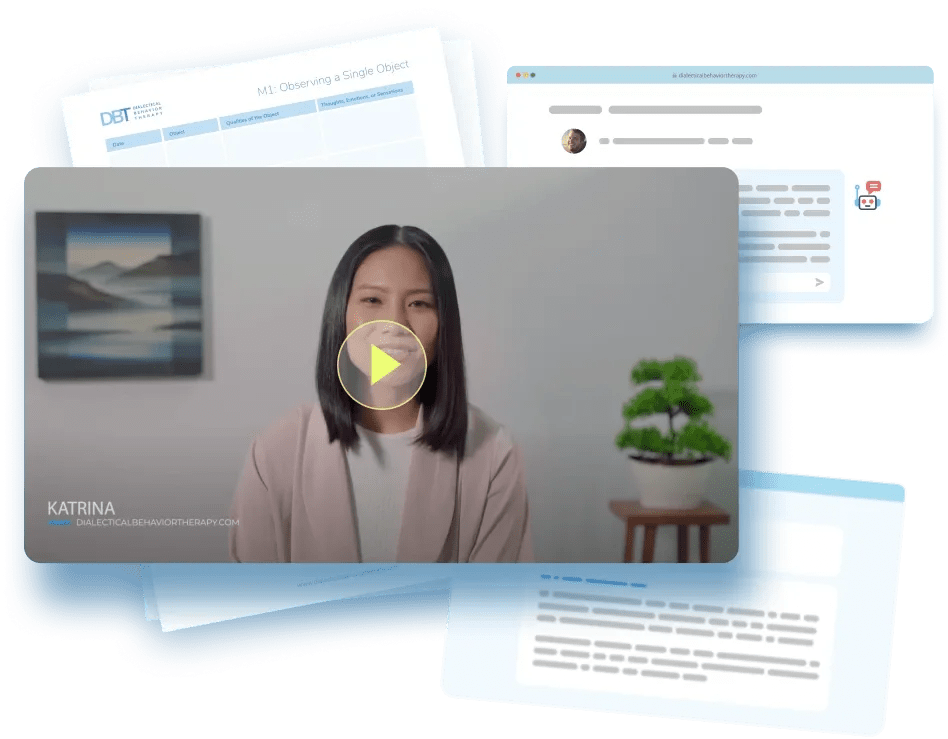What is Self-Monitoring & Awareness?
We move through life at a fast pace. From the moment we wake up, we’re juggling responsibilities: getting ready, heading to work or school, responding to messages, or multitasking on the go. To keep up, our brains rely on autopilot.
This mental autopilot helps us stay efficient, but it can also disconnect us from what we’re actually experiencing. You might not notice how you’re feeling, what thoughts are running through your mind, or how your body is reacting. And when we’re not aware, unhelpful patterns, like anxiety, stress, or self-criticism, can take over without us realizing it.
That’s where self-monitoring comes in.
Self-monitoring is the skill of paying closer attention to your thoughts, feelings, and physical signals in real time. It helps you catch automatic reactions, notice patterns, and start to understand the links between situations, thoughts, emotions, and behaviors. Awareness is the first step toward change.
Self-Monitoring & Awareness as a CBT Module
Cognitive Behavioral Therapy incorporates four key modules, with self-monitoring and awareness as the foundational element. This crucial component is often the starting point in therapy, providing essential groundwork for the other three modules: cognitive restructuring, behavioral activation & exposure, and problem-solving, coping & relapse-prevention.
By first establishing self-monitoring & awareness skills, psychologists set the stage for more effective learning and application of the remaining CBT concepts.
What Self Monitoring & Awareness Skills are taught in CBT?
The Self-Monitoring & Awareness Skills taught in CBT are "Detection" Skills and "Tracking" Skills.
- 1
Detection Skills: These skills help you tune into what you are thinking, feeling, and experiencing in the moment. They’re designed to help you notice internal signals, like a shift in mood, a sudden thought, or physical tension, before they take over. The goal is to catch patterns early so you can respond more thoughtfully instead of reacting on autopilot.
- exercise SM1: Automatic Thought Log Captures real-time mental reactions when mood dips.
- exercise SM5: Body-Signal Scan Identifies early psychical signs of stress.
- exercise SM6: Thought Labeling Increases awareness of the type of thought.
- exercise SM7: Mindful Minute Strengthens attention to the present-moment thought flow.
- exercise SM8: Five-Senses Grounding Anchors you in sensory awareness during distress.
- exercise SM9: Values Check-In Encourages reflection on internal drivers and alignment.
- 2
Tracking Skills:These skills help you record and make sense of what you’ve noticed. Writing things down. Whether it’s thoughts, emotions, behaviors, or triggers, turns passing experiences into useful information. Tracking gives you a clearer picture of what’s happening over time, making it easier to spot patterns, identify triggers, and test out new coping strategies.
- exercise SM2: Mood Thermometer Charts mood over time; trend awareness.
- exercise SM3: Timeline Mapping Maps cause-effect relationships across a single day.
- exercise SM4: ABC Thought Tracker Breaks down the belief-emotion-behavior sequence.
- exercise SM10: Gratitude Reframe Builds habit of identifying emotional perspective shifts over time.
How Do These Self-Monitoring & Awareness Techniques Help?
The self-monitoring & awareness skills taught in CBT play a key role in helping you understand patterns in your thoughts, emotions, and behaviors, making it easier to manage mood, reduce reactivity, and make intentional changes.
By developing greater awareness of your thoughts, feelings, and behaviors, you learn to observe them as they happen instead of getting swept up in them. This skill is essential for breaking the cycle of automatic, often unhelpful, thinking patterns that contribute to emotional distress.
Benefits of Self-Monitoring & Awareness
Even if you are not in therapy, practicing self-monitoring & awareness in your daily life can be highly beneficial. Here are some of the key benefits:
- Overall Wellbeing. By regularly checking in with your thoughts, emotions, and behaviors, you become more aware of how your mind works. This awareness helps you respond more intentionally, reducing emotional reactivity and increasing a sense of control and clarity.
- Better Sleep. When you notice stress patterns or racing thoughts earlier in the day, you can use strategies to manage them before bedtime, leading to a more relaxed mind and improved sleep quality.
- Lowered Stress Response. Self-monitoring helps you recognize and interrupt unhelpful thinking and behavior loops, which lowers physiological stress and can support healthy blood pressure.
- Improved Pain Coping. Being more aware of how your thoughts and emotions affect your physical state can help you respond more effectively to chronic pain conditions and discomfort.
- Stronger Focus and Mental Clarity. Noticing distractions and thought patterns as they arise helps you stay focused on what matters and avoid mental spirals that drain attention.
- Reduced Stress, Anxiety, and Depression. CBT self-monitoring is a proven strategy for identifying and challenging negative thought cycles that drive mood and anxiety issues.
- Healthier Eating and Behavior Change. Increased awareness of urges, triggers, and emotional cues makes it easier to break cycles of binge eating, emotional eating, or other patterns that interfere with your goals.
How to Practice Self-Monitoring & Awareness Skills in Real-Life
CBT emphasizes building awareness of your thoughts, emotions, and behaviors as they unfold. Here are practical ways to apply self-monitoring and awareness skills in daily situations.
Use physical activity as a check-in point. Going for a walk, stretching, or doing a short workout gives you a natural pause to scan your thoughts, mood, and physical tension. You do not need a gym. Just moving your body can help you reconnect with what you're feeling and thinking in the moment.
Reflect while doing something meaningful. Volunteering or helping others can bring up a range of thoughts and emotions. Use these moments to notice what comes up for you: self-talk, urges, assumptions, and jot them down later. This kind of reflection builds insight into what matters to you and how you respond in different roles.
Practice calming techniques with observation. When using tools like deep breathing or grounding, take a moment to also observe what’s happening in your mind and body. What changed? Did any thoughts pop up? This makes the calming practice not just soothing, but informative.
Note and challenge recurring self-talk. Each day, try to notice one automatic thought that shows up often. Write it down and ask yourself: Is this helpful? Is it accurate? You can also create realistic counter-statements, like “I’ve handled things like this before” or “I’m noticing worry, not danger.”
Subscribe.
Get the DBT course. Free!
Get your full access to our 26-week DBT course.
Lessons emailed to you twice a week.

Frequently Asked Questions
Self-monitoring is the practice of noticing and tracking your thoughts, feelings, behaviors, and physical sensations as they happen. It helps you recognize patterns, make sense of emotional reactions, and better understand how situations influence your mood. The goal is to build awareness so you can respond more intentionally instead of reacting automatically.
When you increase your self-awareness, you become better at spotting unhelpful thinking habits, emotional triggers, and behavior loops. This makes it easier to interrupt cycles that lead to stress, anxiety, or low mood. Greater awareness also helps you build healthier coping strategies and make choices that reflect your values.
Yes! The CBT self-monitoring tools and exercises on this site are suitable for teens. Many teens find mood trackers, thought logs, and body scans helpful for managing emotions, especially during stressful situations like school, friendships, or family conflict. It’s a great way to build emotional insight early on.
If you often feel overwhelmed without knowing why, struggle to name your emotions, or notice that you act impulsively and regret it later, these might be signs that you could benefit from more self-monitoring. Learning to pause, reflect, and track what’s going on inside helps bring clarity and creates space for change.
References
- Beck, J. S. “Cognitive Behavior Therapy: Basics and Beyond” (2nd ed.).
- Kazantzis, N., Whittington, C., & Dattilio, F. “Meta-analysis of homework assignments in CBT: The value of self-monitoring.” Psychotherapy: Theory, Research, Practice, Training, 47(1), 14–24.
- Greenberger, D., & Padesky, C. A. "Mind Over Mood: Change How You Feel by Changing the Way You Think"
- Nelson, R. O., & Hayes, S. C. Theoretical Explanations for Reactivity in Self-Monitoring. Behavior Modification, 5(1), 3-14.
- Cristea, I. A., et al. Efficacy of Cognitive Behavioral Therapy: A Review of Meta-Analyses. Cognitive Therapy and Research, 39(5),536-549.



